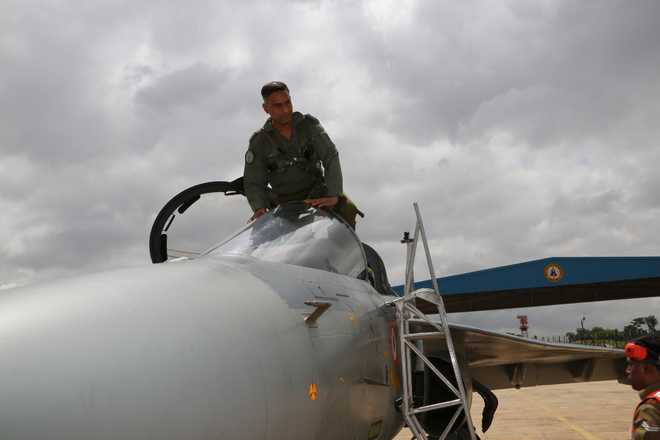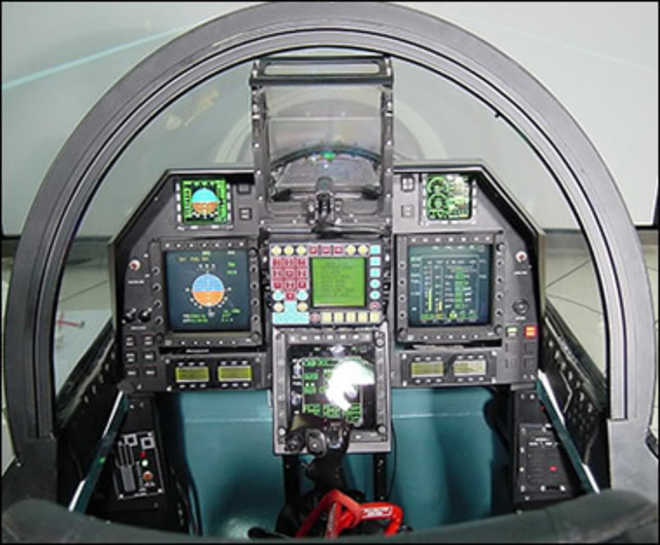
Light Combat Aircraft (LCA) Tejas

Ajay Banerjee
Tribune News Service
New Delhi, July 1

The country’s first indigenously built Light Combat Aircraft (LCA), the Tejas, was today inducted into Indian Air Force (IAF), making it an important day in the history of India’s defence manufacturing efforts.Group Captain Madhav Rangachari will command ‘Flying Daggers’ — the first squadron of Tejas. He flew the inaugural flight of the plane in Bengaluru today.(Follow The Tribune on Facebook and Twitter @thetribunechd)Only two planes have been inducted so far and the entire squadron of 18 planes will be built over the next two years. Six more planes will join in by December-end. The euphoria of history apart, the real test of maker Hindustan Aeronautics Limited (HAL), a public sector undertaking of the Ministry of Defence, starts now. The HAL has been asked to deliver two successive improved versions of Tejas with the second version called “Tejas Mark 1-A” to start production in 2019.These will include new generation active electronically scanned array (AESA) radar which simultaneously tracks and aims at targets in the air and ground, an advanced electronic warfare suite, addition of latest beyond visual range (BVR) of missiles, mid-air refuelling facility and greater war fighting abilities. In all, 43 improvements will be made in the existing plane.”These additions will make the plane truly world class. Today is a historic day and signals ours growth,” said Air Marshal Kapil Kak (retd).In all, 120-125 planes are to be produced and with HAL’s existing capacity of making eight planes annually. This may take up to 15-17 years. The HAL has been asked to produce 16 jets annually and a Rs 1,252-crore modernisation plan has been approved to ramp up capacities.Tejas will fill in the void created by MiG-21s and MiG-27s that will be phased out by 2022. The IAF needs 400 jets over the next 10 years. The gap is slated to be filled by 36 Rafale jets, 80-100 fifth generation fighter aircraft to be co-produced with Russia and another 80-100 Rafale-type medium combat jets.
Of national pride and happiness!Induction of indigenously made Tejas fighter jet into the Air Force fills our hearts with unparalleled pride and happiness…I laud HAL and ADA on the induction of Tejas fighter jet. This illustrates our skills and strengths to enhance indigenous defence manufacturing. Narendra Modi, Prime MinisterCongratulations to Hindustan Aeronautics Limited and Aeronautical Development Agency for successful induction of the indigenously developed Tejas fighter jet…Moment of National pride…Tejas will take our air strength to new heights. Manohar Parrikar, Defence Minister
33 years in makingRs 10,397.11 cr Spent so far
1983Conception year
Makers Hindustan Aeronautics Limited & Aeronautical Development Agency
Made up of
42%carbon fibre composites
43%aluminium alloy
15%titanium alloy
Two delivered2 Aircraft in new ‘Flying Daggers’ squadron18 Planes to be ready by 2018MiG-21 To be replaced by Tejas
Supersonic LCA
1,300 km/hr(1.6 Mach) Speed
4 tonnesPayload capacity
2,000 hours Test flying
‘I felt on top of the world’Flying the indigenous Tejas LCA after its induction into the IAF was like being on top of the world, said Group Captain Madhav Rangachari on Friday. “I felt like being on top of the world when flying the Tejas fighter. It’s an honour and a privilege to pilot the inaugural flight of the LCA soon after its induction,” Rangachari told reporters after a 10-minute solo sortie under a cloudy sky and windy conditions. The 40-year-old test pilot is the commanding officer of the IAF’s 45 squadron nicknamed “Flying Daggers”. With 3,000 flying hours’ experience, Rangachari was part of the Mirage 2000 squadron before flying the multirole Tejas since a year. “I could do only horizontal profile and not vertical due to the cloudy sky. It’s an excellent aircraft and generation ahead of other fighters in the world,” Rangachari said. — IANS
IAF adds muscle power with Tejas
A milestone in country’s military aviation, officials say aircraft will be used for air-to-air and air-to-ground strikes
THE REAL CHALLENGE IS HOW FAST THE TEJAS CAN MATURE INTO A FULL-FLEDGED FIGHTER JET
From page 01 NEW DELHI: The Indian government officially announced the induction of the Tejas Light Combat Aircraft (LCA) into the air force on Friday. This is a landmark development in Indian aeronautical technology. Yet it has to be seen if the aircraft, for both technical and production reasons, can cover a dangerous gap in India’s airpower. TECHNICAL TEST The purpose of the LCA was to replace the lightweight component of the IAF, largely composed of its obsolete Mig-21s and ageing Mirage 2000s. It is technologically far superior to the various types of Mig-21s, aircraft that were designed in the 1960s and put away in museums everywhere else. But the Tejas real test is whether it can better its equivalents in the Pakistani and Chinese air forces: respectively, the JF-17 and J-10.
Former Air Vice-Marshal Kapil Kak, based on conversation with pilots who have flown both the JF-17 and the Tejas, says, “The Tejas is far superior to the JF-17.” However, it is questionable if the Tejas is upto scratch when it comes to the Chinese J-10. The latter has received good reviews even in the US. Ashley Tellis of the Carnegie Endowment, in a report on the IAF, notes the J-10 has “turned out to be an impressive lightweight fourth-generation combatant.” And it is far ahead on the development curve than Tejas. The LCA was initially envisaged to allow India to leapfrog ahead of its principal military rivals in the region, with claims it would be a 1000 kgs lighter and so on. According to those who have flown it, the LCA is remarkably manoeuvrable and agile, especially in turning.
But it is on par rather than decisively superior to comparable airplanes. The Tejas empty weight, for example, of 6560 kgs and a fully-loaded weight of 13,500 kgs, no real improvement on the much older Mirage 200C’s figures of 7,500 kgs and 17,000 kgs. Executives of major international defence companies say the Tejas has poor thrust-to-weight ratio and a limited top speed given how new it is. It also uses an Israeli EL/M-2052 radar that is inferior to the US counterparts used by Pakistan. The Israeli Air Force prefers the US radar over the EL/M-2052. PRODUCTION TEST The real challenge is how fast the Tejas can mature into a fully mature fighter and how fast it can be churned out. The Indian Air Force is already suffering a crisis in numbers and, in the coming decade, will be forced to retire many of its old fighters. The evidence is that Tejas fighters will trundle off the assembly lines too slowly to matter.
The first problem is that what is being inducted in the air force right now is not the finished fighter. This is the Initial Operational Clearance model, a functional early variety that will be used to help detect teething problems in the aircraft. This will then be followed by a Final Operational Clearance model and then, in theory, a final battle space-ready product, the Tejas 1A. What is being rolled out now, says Kak, cannot be deployed in sensitive combat theatres in the east and west “for at least 10 years.” And the Tejas 1A may not make an appearance until 2030 or so.
The second problem is how fast Hindustan Aeronautics can actually produce the Tejas. At present, HAL can only churn out eight aircraft a year against an IAF minimum requirement of 18 aircraft a year. “Half a squadron a year is the rate of induction we can hope for, in the best of circumstances,” says Kak.
In the meantime, IAF is facing a steady attrition in its numbers from crashes and simple age.
India’s domestically-developed light combat aircraft formally joined the IAF and flew on its first sortie in Bengaluru on Friday

